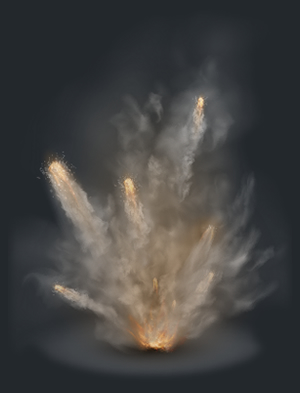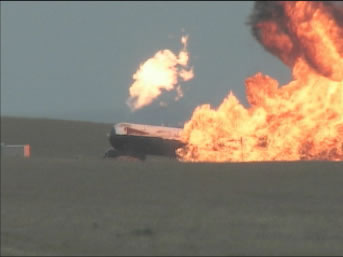SERVICES

Vent and Burn, A controlled method of emptying Pressurized Flammable Liquid Vessels
 In the event of a road or rail accident were the transport vessel is damaged and cannot be drained by standard or conventional methods, one method for rendering the vessel save is to use the Vent and Burn technique. DAMet Services Ltd. has developed a method to allow a tanker or vessel to be emptied and burned off in a controlled manner. In collaboration with Transport Canada and the LPG industry, this system has been tested and used in real emergency situations. Although primarily focused at the LPG transportation industry the technique can also be used to drain or vent and burn any flammable liquid from almost any vessel.
In the event of a road or rail accident were the transport vessel is damaged and cannot be drained by standard or conventional methods, one method for rendering the vessel save is to use the Vent and Burn technique. DAMet Services Ltd. has developed a method to allow a tanker or vessel to be emptied and burned off in a controlled manner. In collaboration with Transport Canada and the LPG industry, this system has been tested and used in real emergency situations. Although primarily focused at the LPG transportation industry the technique can also be used to drain or vent and burn any flammable liquid from almost any vessel.
Comments from Transport Canada on Vent and Burn:
Simply put, ‘Vent and Burn’ is a controlled burn of the contents of a liquified petroleum gas (LPG) tank truck, rail car or storage tank when no other reasonable options exist. It is a technique of last resort, used to:
-
-
- prevent a catastrophic tank failure;
- avoid uncontrolled release of propane into the environment; and
- reduce the time required to handle such an emergency.
-
This video demonstrates, but does not endorse, the vent and burn procedure. It is very dangerous and may not produce results as planned. It should be used only by persons highly trained to assess risk, assess tank damage, and the use of explosives.
Transportation Emergencies involving Class 1 products
DAMet Services personal have been involved with the transportation of Class 1 (Explosives) products for over 25 years and has been involved in the cleanup of accident sites involving transportation vehicles damaged in accidents.
Commonly the nature of an accident will see a transport unit damaged/ruptured and products can be spread over the accident site.
Clean up of explosive materials must be handled far more carefully than standard consumer or industrial products.
Personnel trained in the recognition and handling of these materials is extremely important to safety on the scene and to the public.
Evaluation of the transport manifest gives the cleanup team a starting point for identifying, finding and accounting for all product during the cleanup.
Repackaging to ensure that the product is safe and stable for transport and arranging for continued transport to proper storage facilities is critical.
Vent and Burn, A controlled method of emptying Pressurized Flammable Liquid Vessels
 In the event of a road or rail accident were the transport vessel is damaged and cannot be drained by standard or conventional methods, one method for rendering the vessel save is to use the Vent and Burn technique. DAMet Services Ltd. has developed a method to allow a tanker or vessel to be emptied and burned off in a controlled manner. In collaboration with Transport Canada and the LPG industry, this system has been tested and used in real emergency situations. Although primarily focused at the LPG transportation industry the technique can also be used to drain or vent and burn any flammable liquid from almost any vessel.
In the event of a road or rail accident were the transport vessel is damaged and cannot be drained by standard or conventional methods, one method for rendering the vessel save is to use the Vent and Burn technique. DAMet Services Ltd. has developed a method to allow a tanker or vessel to be emptied and burned off in a controlled manner. In collaboration with Transport Canada and the LPG industry, this system has been tested and used in real emergency situations. Although primarily focused at the LPG transportation industry the technique can also be used to drain or vent and burn any flammable liquid from almost any vessel.
Comments from Transport Canada on Vent and Burn:
Simply put, ‘Vent and Burn’ is a controlled burn of the contents of a liquified petroleum gas (LPG) tank truck, rail car or storage tank when no other reasonable options exist. It is a technique of last resort, used to:
-
-
- prevent a catastrophic tank failure;
- avoid uncontrolled release of propane into the environment; and
- reduce the time required to handle such an emergency.
-
This video demonstrates, but does not endorse, the vent and burn procedure. It is very dangerous and may not produce results as planned. It should be used only by persons highly trained to assess risk, assess tank damage, and the use of explosives.
Transportation Emergencies involving Class 1 products
DAMet Services personal have been involved with the transportation of Class 1 (Explosives) products for over 25 years and has been involved in the cleanup of accident sites involving transportation vehicles damaged in accidents.
Commonly the nature of an accident will see a transport unit damaged/ruptured and products can be spread over the accident site.
Clean up of explosive materials must be handled far more carefully than standard consumer or industrial products.
Personnel trained in the recognition and handling of these materials is extremely important to safety on the scene and to the public.
Evaluation of the transport manifest gives the cleanup team a starting point for identifying, finding and accounting for all product during the cleanup.
Repackaging to ensure that the product is safe and stable for transport and arranging for continued transport to proper storage facilities is critical.

